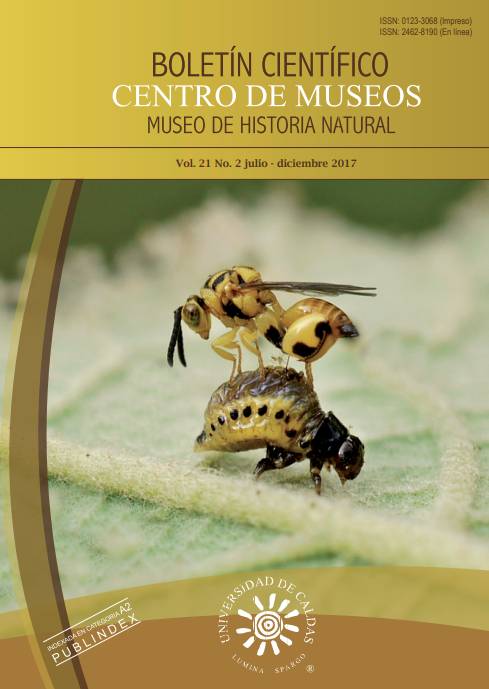Authors
Abstract
The effect of vegetable diets on the larval development of two daytime butterflies in captivity at the Allpahuayo Research Center of the Instituto de Investigaciones de la Amazonía Peruana (IIAP), Iquitos, Peru, was determined. To evaluate their biological cycles, 20 freshly emerged larvae of each species were used individually and, to estimate the effect of different diets in their larval development, a completely randomized design was used with two treatments and different replicates (n1 = 31 and n2 = 14). It was reported that the diet with the host plant Arachis pintoi was optimal for both Morpho menelaus occidentalis and Morpho helenor theodorus species, which completed their biological cycles in, 97.51±7.98 days (n = 15), with 75% survival, and 73.22±7.26 days (n = 14), with a survival rate of 70% respectively. Morpho helenor theodorus completed its biological cycle on its natural host plant Platymiscium stipulare in 75.84±10.19 days (n = 10), being its biological cycle longer with a lower survival rate (50%). The host plants Vigna aff. candida and Desmodium adscendens were not adequate for the two species of Morpho, since the larvae died in the first stage. In Morpho helenor theodorus, there is no relationship between gender and diet in relation to longevity (Chi square test). Females lived in average 53.76 days and males 25.45 days.
References
ANDREWS, K.L. & QUEZADA, J.R., 1989.- Manejo integrado de plagas insectiles en la agricultura: estado actual y futuro. Escuela Agrícola Panamericana, Departamento de Protección Vegetal, Zamorano.
CLARO, R. & RUIZ, N., 2010.- Aceptación de una dieta artificial por larvas de la mariposa Battus polydamas polydamas (Lepidoptera: Papilionidae). Acta Biol. Colomb., 15 (1): 47-62.
CONSTANTINO, L.M., 1996.- Ciclos de vida y plantas hospederas de lepidópteros diurnos con potencial económico en condiciones de colinas bajas del Chocó biogeográfico: 75-86 (en) OSORIO, H. (ed.) Memorias del II seminario sobre investigación y manejo de fauna para la construcción de sistemas sostenibles. CIPAV, Cali.
GALLUSSER, S., RAMÍREZ, C. & BLANDIN, P., 2010.- Observaciones sobre el desarrollo y polimorfismo de Morpho (Iphimedeia) telemachus (Linnaeus, 1758) en el noreste Peruano (Lepidoptera, Nymphalidae, Morphinae). Bull. Soc. Entomol. Fr., 115 (1): 5-15.
GENTRY, A., 1993.- A field guide to the families and genera of woody plants of northwest South America (Colombia, ecuador, Perú) with supplementary notes on herbaceous taxa. Conservation International, Washington DC.
HOLLOWAY, G.J., BRAKEFIELD, P.M., KOFMAN, S. & WINDIG, J.J., 1992.- An artificial diet for butterflies, including Bicyclus species, and its effect on development period, weight and wing pattern. J. Res. Lepid, 30 (1-2): 121-128.
HURTADO, L., 2009.- Descripción del ciclo biológico de Utetheisa ornatrix venusta (Dalm) (Lepidoptera: Arctiidae) con una dieta artificial. Centro Agrícola, 36 (4): 79-84.
JAENIKE, J., 1990.- Host specialization on phytophagous insects. Ann. Rev. Ecol. Syst., 21 (1): 243-273.
JUDD, W.S., CAMPBELL, C.S., KELLOG, E.A., STEVENS, P.F. & DONOGHUE, M.J., 1999.- Plant systematics: A phylogenetic approach. Sinauer, Sunderland, MA.
MORENO, R., 1998.- Análisis económico del proyecto de fauna: cría de mariposas. Instituto Von Humboldt, Bogotá.
MULANOVICH, A., 2007.- Guía para el manejo sustentable de las mariposas en el Perú. Instituto de Investigaciones de la Amazonía Peruana, Iquitos.
ORSAK, L., 1993.- Killing butterflies to save butterflies: a tool for tropical forest conservation in Papua New Guinea. News Lepid. Soc., 35 (3): 71-80.
RAMÍREZ, C., GALLUSSER, S., LACHAUME, G. & BLANDIN, P., 2014.- The ecology and life cycle of the Amazonian Morpho cisseis phanodemus Hewitson, 1869, with a comparative review of early stages in the genus Morpho (Lepidoptera: Nymphalidae: Morphinae). Trop. Lepid. Res., 24 (2): 67-80.
RAMÍREZ, J., 1994.- Manejo de fauna silvestre y los límites previsibles de la sustentabilidad: 1-23 (en) Seminario de investigación y manejo de fauna para el desarrollo de sistemas sostenibles de producción en el trópico, Pontificia Universidad Javeriana, Cali.
RIBEIRO, J.E.L.S., HOPKINS, M.J.G., VICENTINI, A., SOTHERS, C.A., COSTA, M.A.S., BRITO, J.M., SOUZA, M.A.D., MARTINS, L.H.P., LOHMANN, L.G., ASSUNÇÃO, P.A.C.L., PEREIRA, E.C., SILVA, C.F., MESQUITA, M.R. & PROCÓPIO, L.C., 1999.- Flora da Reserva Ducke. Guia de identificação das plantas vasculares de uma floresta de terra-firme na Amazônia Central. Instituto Nacional de Pesquisas da Amazônia, Manaus.
RINCÓN, C.A., 1999.- Maní forrajero (Arachis pintoi) la leguminosa para sistemas sostenibles de producción agropecuaria. Información Técnica Corpoica, 3 (24): 2-8.
ROJAS, A., 2007.- Ventajas y limitaciones para el uso del maní forrajero perenne (Arachis pintoi) en la ganadería tropical: 88-99 (en) 9° Seminario de manejo y utilización de pastos y forrajes en sistemas de producción animal. Asociación Venezolana de Producción Animal, Barquisimeto.
RUIZ, E., VÁSQUEZ, J., ZÁRATE, R. & PINEDO, J., 2015.- Aspectos biológicos de Morpho helenor theodorus (Fruhstorfer) (Lepidoptera: Nymphalidae; Morphinae) y Mechanitis polymnia (Linnaeus), (Lepidoptera: Nymphalidae; Ithomiinae), en la Amazonia baja del Perú. Folia Amazónica, 24 (1): 45-54.
SALAZAR, J.A., VARGAS, J.I., MORA, A.M. & BENAVIDES, J., 2010.- Identificación preliminar de los Rhopalocera que habitan el Centro Experimental Amazónico (C.E.A.) Mocoa-Putumayo y algunas especies aptas para criar en cautiverio (Insecta: Lepidoptera). Bol. Cient. Mus. Hist. Nat. U. de Caldas, 14 (1): 150-188.
SILVA, K.L., 2005.- Interações evolutivas entre borboletas da tribo Troidini (Papilionidae, Papilioninae) e suas plantas hospedeiras no gênero Aristolochia (Aristolochiaceae): Tesis, Instituto de Biologia, Universidade Estadual de Campinas, São Paulo.
SOTO, J. & IANNACONE, J., 2008.- Efecto de dietas artificiales en la biología de adultos de Chrysoperla externa (Hagen, 1861) (Neuroptera: Chrysopidae). Acta Zool. Mex., 24 (2): 1-22.
VALLE, P., 2000.- Toxicología de alimentos. Instituto Nacional de Salud Pública, Centro Nacional de Salud Ambiental, México.
VÁSQUEZ, J., ZÁRATE, R., HUIÑAPI, J., PINEDO, J., RAMÍREZ, J.J., LAMAS, G. & VELA, P., 2017.- Plantas alimenticias de 19 especies de mariposas diurnas (Lepidoptera) en Loreto, Perú. Rev. Peru. Biol. 24 (1): 35-42.
VÁSQUEZ, R., 1997.- Flórula de las reservas biológicas de Iquitos, Perú. Missouri Botanical Garden, St. Louis.
VÁSQUEZ, R. & ROJAS, R., 2004.- Plantas de la Amazonía peruana clave para identificar las familias de Gymnospermae y Angiospermae. Arnaldoa, 13 (1): 1-261.
YOUNG, A.M., 1974.- The rearing of the neotropical butterfly Morpho peleides (Nymphalidae) on peanuts. J. Lepid. Soc., 28 (2): 90-99.

 PDF (Español)
PDF (Español)
 FLIP
FLIP






















